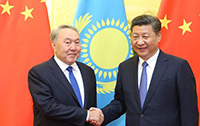Backgrounder: New forms of partnership
(UNECA) Updated: 2014-10-14 10:53IV. New partnerships and African priorities
10. There is considerable scope for innovative partnerships to support Africa's transformative agenda, including in the area of trade, where regional integration can undoubtedly underpin Africa's development. In that regard, it is estimated that the establishment of the proposed continental free trade area could double intra-African trade and stimulate the emergence of more sophisticated trade networks. Promoting regional integration should therefore be made a key medium-term policy priority, and efforts must be made to cut tariffs and remove technical and administrative barriers to trade across the region.
11. Rising labour costs in China and other major manufacturing countries could create opportunities to foster Africa's industrialization and economic diversification, thereby generating productive employment for Africa's expanding labour force. On the other hand, however, emerging economies' growing demand for Africa's natural resources could risk reinforcing African countries' dependence on primary commodity exports, especially if developed economies do not provide a vibrant market for other African products. This provides the conceptual basis for engaging Southern partners in a more strategic way, ensuring that South-South trade relations promote value addition and foster the emergence of regional value chains.
12. The emergence of new donors and innovative aid modalities are making it possible to exploit synergies between partners at the national, regional and global levels with a view to mobilizing investments for a range of initiatives, including, in particular, infrastructure projects. In that regard, African countries must assume full ownership of the continent's infrastructural development agenda, as articulated by the Programme for Infrastructure Development in Africa, and must enhance their coordination at regional level and with the donor community so as to best exploit emerging opportunities. South-South cooperation can, moreover, help countries identify common interests, and formulate common positions on the management of the global commons and reforms of the multilateral trade and financial systems.
13. With regard to new partnerships in the area of development finance, the disproportionately high costs of formal remittance services deprive Africa of much-needed funds to finance consumption and physical and human capital investments. Indeed, according to the World Bank, if the cost of remitting funds to sub-Saharan African countries had matched average global costs, sub-Saharan remittance receipts in 2010 would have been $6 billion higher. It is estimated that over 50 per cent of remittances to the region are sent through informal channels. Enhanced cooperation is therefore needed to cut the costs associated with formal remittance channels and promote their use. Innovative financial instruments, such as diaspora bonds, could also help African countries to mobilize additional remittances from abroad and spur investment.
14. Given the small size of most African financial markets and the high costs associated with establishing robust regulation and oversight mechanisms, regional or subregional financial hubs could be established with a view to creating vibrant and appropriately regulated financial markets that would, among other things, provide for the issuance of debt denominated in local currencies. In that vein, the African Development Bank has already supported the issuance of bonds denominated in local currency at the Uganda Securities Exchange, and is planning to do the same in Kenya, Ghana and the United Republic of Tanzania.
15. Legal loopholes, inefficient revenue collection systems and massive illicit financial flows, which the Economic Commission for Africa estimates may be as high as $50 billion per year, continue to impede revenue collection by African countries. In that regard, a study of five African countries conducted by Global Financial Integrity in 2014 revealed that trade misinvoicing alone was reducing Government revenue by as much as 11 per cent in Ghana, 8.3 per cent in Kenya, 10.4 per cent in Mozambique, 12.7 per cent in Uganda, and 7.4 per cent in the United Republic Symposium for African LDCs, Mwanza, 14-16 May 2014).
16. Africa requires approximately $200 billion annually to finance sustainable development, promote climate change adaptation and mitigation, and enhance economic resilience and competitiveness. Africa's infrastructure requirements alone are estimated at $93 billion per year. The costs of safeguarding Africa's natural resources, which continue to underpin most growth in the continent, are also increasing. For example, $2 billion is needed annually just to mitigate the effects of deforestation and forest degradation and $22 billion a year is required to promote the sustainable development of Africa's water resources. To achieve the Millennium Development Goals and the objectives of the Comprehensive Africa Agriculture Development Programme, approximately $8.55 billion must be invested annually in African agriculture. That sum is a small fraction of the estimated $198 billion per year that will be required globally until 2050 for the promotion of environmentally sustainable agriculture, or the $125 billion that the World Economic Forum forecasts must be invested annually until 2030 in primary agriculture in developing countries. For developing countries to access the funds they require, they must strive to mobilize additional financial resources, including by accessing financial markets, while developed countries must honour the financial commitments they have made in international forums.
17. Furthermore, the impact of the Copenhagen Accord, which calls for $100 billion to be raised per year by 2020 from a wide variety of sources to help developing countries cut their carbon emissions, could be enhanced if it is implemented in tandem with other mechanisms to address climate change, such as the Global Environment Facility and the United Nations REDD-plus mechanism. Increasingly, the public and private sectors are investing in sustainable development. This is particularly the case in the renewable energy sector, which attracted $211 billion in new investment in 2010. Since 2006, over $15 billion has been raised through green bond issuances to finance projects with sizeable environmental gains. In the light of the above, Africa's underdeveloped capital markets and the high costs associated with raising capital across the continent present huge opportunities for regional and subregional collaboration with a view to enhancing African countries' financial sectors and promoting regional integration.




